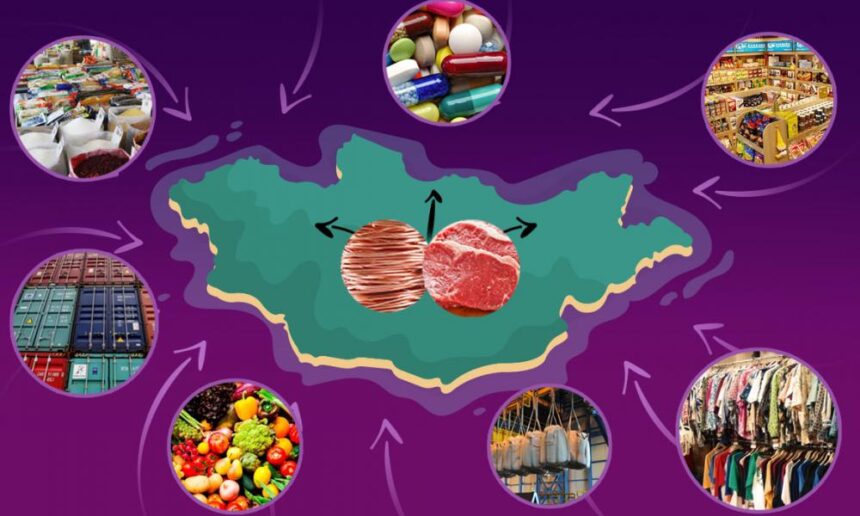Trade is the transfer of goods and services from one person or organization to another in exchange for money. A trade network is called a market. Such transfers between countries is called foreign trade. The process of selling consists of utilizing domestic resources to meet one’s own needs and supplying the surplus to others.
Mongolia is a trading nation. Mongolia is one of the countries that have a high trade-to-GDP ratio. According to a World Bank report, Mongolia’s ratio was 129 percent in 2019 while Canada had a ratio of 56 percent. Moreover, the terms of trade – the ratio of exports to imports- shows that our country usually has a deficit.
How do countries develop through trade? What are Mongolia’s prime concerns in trade? How can we increase the trade output?
Stages of development and free trade
Whether an underdeveloped country becomes a middle-income country depends on how successfully it takes part in regional and global trade. Successful trade is the mechanism that increases foreign exchange reserves to ensure the country’s balance of payments, and to secure imports of the necessary equipment, technology and energy, as well as developing domestic manufacturing for export and reducing commodity prices.
There are three stages to go through before trade brings development. First, the country uses its relative advantages to export its natural commodities. The income is then used to develop domestic production to replace imports. For instance, vegetable farmers often build a vegetable processing plant. Third, export products are produced using cheap labor. The cost per unit decreases when exporting to a larger external market and supplying the domestic market at the same time. (Economies of scale)
Mongolia is currently only at the first stage. Imports have been replaced for few small products. Mongolia has been actively involved in coalitions and unions formed by the countries in the region and its neighbors. Having a presence among our neighbors, however minor it might be, is not only a boon for foreign trade, but also a guarantee of independence and security for a small country like ours.
The trade with our southern neighbor is profitable and a “coal diplomacy” is maintained whereas the trade with our northern neighbor is very unbalanced and has a huge deficit. An offer was made to Mongolia for joining the Eurasian Economic Union and to sign a free trade agreement aforehand. This needs further research. It is estimated that the deal is expected to increase bilateral trade by $ 250 million, or just two percent, thus, not a strong reason to rush.
Mongolia joined the World Trade Organization in 1997. Today, we are a relatively open and free market. Customs tariffs on most goods are 5 percent. Meanwhile our neighbors have tariffs of 20-40 percent. There is no reason to be closed anyway. As trade develops, the market will expand followed by the creation of production and services.
Currently, Mongolia has only one free trade agreement which was signed with Japan in 2016. In 2015, the two countries’ trade amounted to $ 294 million and the figure doubled in four years. Our imports doubled, while exports fell from $ 20 million to $ 15 million. Our products do not meet the Japanese requirements and standards. Our imports almost entirely consist of automobiles, most of which are cars with wheels on the wrong side that were used for many years.
In Mongolia, there is a lot of talk at all levels about exporting livestock products. However, agriculture is a closed sector that protects the domestic market and receives subsidies from the government in most countries. Basically, we have a lot of goods to buy from others, but almost none to sell.
Business environment
Mongolia continues to earn significant revenues from the sale of copper and coal to its southern neighbor. However, this income does not go beyond paying for consumption and we are still struggling to build economic competitiveness. As of 2019, Mongolia was ranked 102nd in the world by the competitiveness index and this is not a big change from the 117th place which we held a decade ago.
The business environment is poor. Mongolia ranked 56th four years ago and 81st today in the Environment for Doing Business Index by the World Bank. Out of the ten indicators, the ranking in “border trade” was 143. This indicator shows the time and cost of exporting and importing goods. An average of 168 hours is spent on getting export documents in Mongolia which is 73 times longer than in developed countries and, three times longer than that of the countries in the region. It takes 134 hours to clear customs, which is 10 times more than in developed countries. In East Asia, this process takes 57.5 hours (Ease of Doing Business 2020). This fact shows where to start with promoting foreign trade.
Before a free trade agreement is discussed, our business environment needs to be improved and national industries should be developed. Then we need to proceed by giving our domestic producers a way to expand and open their export market.
Funding development
The majority of foreign investment in Mongolia makes its way to the mining sector. Crucial investments in other sectors must be financed by the government from mining revenues. It is especially necessary to invest in the development of products and services that would be capable to compete in the global market.
In the United States, for example, the “Small Business Innovation Development Act” was passed in 1982, creating a public-private consortium. It has funded baseline research in many sectors, leading to the creation of many innovative businesses and start-ups. High-cost research laying the basis of today’s Internet and computers was funded by the state and then large companies such as Apple and Tesla emerged. Chile, a country similar to us, has a lot of experience in this area. Then, there is a tradition that the directors of the Development Bank, which is supposed to finance our development, go to court one after another.
Foreign trade also carries certain risks. Fluctuations in world market prices directly affect export earnings and profits. Exports are also affected by risks such as geopolitical uncertainty and cyclical changes in demand. Also, excessive economic liberalization increases unemployment from structural change in some sectors.
The world has long believed that free trade and globalization will benefit all, and that people’s lives will be better. With the advent of cross-border trade, millions of people have been lifted out of poverty and their lives have been improved. However, politicians and economists in many countries now say that while many countries will benefit from a global free trade regime, not everyone is a winner.
2020.10.01
Trans. by Riya.T and Munkh-Erdene.D







